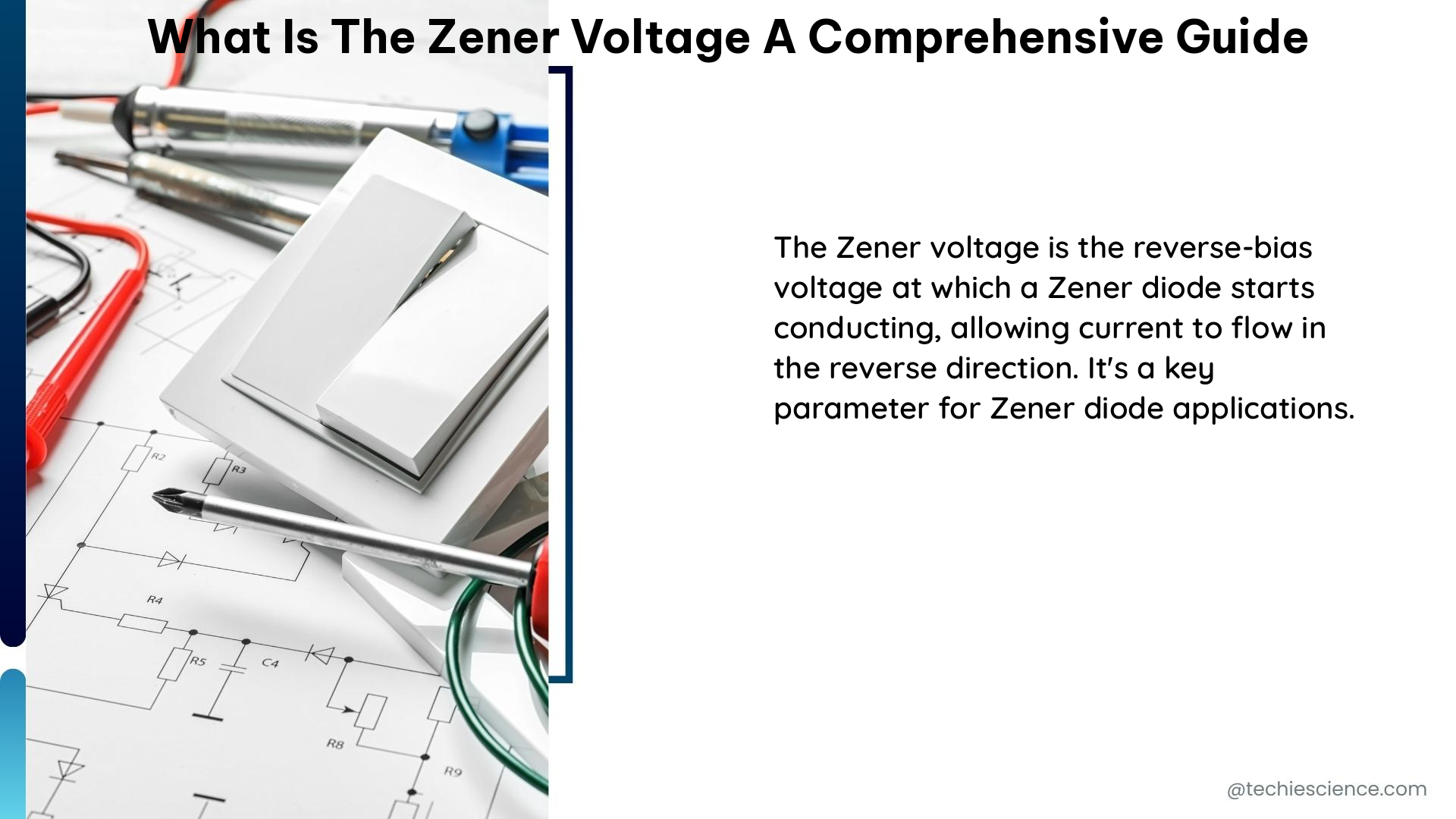Zener diodes are a crucial component in electronic circuits, and their performance is largely determined by the Zener voltage, a critical parameter that defines the reverse voltage at which the Zener breakdown occurs. This comprehensive guide delves into the intricacies of Zener voltage, its significance, and the associated characteristics that are essential for understanding and effectively utilizing Zener diodes in various applications.
Understanding Zener Voltage
Zener voltage, denoted as Vz, is the reverse voltage at which the Zener breakdown phenomenon occurs in a Zener diode. This breakdown is a unique characteristic of Zener diodes, where the diode exhibits a sharp increase in current while maintaining a relatively constant voltage drop across its terminals. The Zener voltage is set during the manufacturing process by controlling the doping level of the semiconductor material used in the diode.
Commercially available Zener diodes typically have Zener voltages ranging from 2.4 volts to around 200 volts, catering to a wide range of voltage regulation and protection requirements. The specific Zener voltage of a diode is a crucial factor in determining its suitability for a particular application, as it directly affects the diode’s ability to maintain a stable output voltage.
Zener Resistance (Rz)

Another essential characteristic of Zener diodes is the Zener resistance, denoted as Rz. This parameter represents the dynamic resistance of the diode in the Zener breakdown region, and it is calculated as the ratio of the change in voltage (ΔVz) to the corresponding change in current (ΔIz) within the breakdown region.
The Zener resistance is typically inversely proportional to the Zener voltage. Zener diodes with higher breakdown voltages generally exhibit lower Zener resistance, while those with lower breakdown voltages have higher Zener resistance. This relationship is important to consider when selecting a Zener diode for a specific application, as the Zener resistance affects the diode’s ability to maintain a stable output voltage under varying load conditions.
Maximum Reverse Current
The maximum reverse current, also known as the maximum Zener current, is another crucial parameter to consider when working with Zener diodes. This parameter represents the maximum current that a Zener diode can safely allow to flow through it when it is reverse-biased and operating in the Zener breakdown region.
Exceeding the maximum reverse current can lead to excessive power dissipation within the diode, potentially causing thermal damage or even device failure. It is essential to ensure that the Zener diode is rated for the maximum current it may be exposed to, especially in applications where transient overvoltage conditions may occur.
Zener Diode Applications
Zener diodes find widespread use in various electronic circuits and applications due to their unique voltage regulation and protection capabilities. Some of the common applications of Zener diodes include:
-
Voltage Regulation: Zener diodes are extensively used in voltage regulation circuits, where they maintain a constant output voltage across a load, regardless of fluctuations in the input voltage or changes in the load.
-
Waveform Clipping: Zener diodes can be employed in waveform clipping circuits, where they limit the amplitude of an input signal to a specific level, effectively “clipping” the waveform.
-
Transient Voltage Suppression: Zener diodes are used to protect sensitive electronic components from voltage spikes and transient overvoltage conditions, acting as a protective barrier against potentially damaging voltage surges.
Zener Diode Characteristics and V-I Curve
The voltage-current (V-I) characteristics of a Zener diode are typically represented by a graphical curve known as the Zener diode V-I curve. This curve illustrates the relationship between the voltage across the diode and the current flowing through it, particularly in the Zener breakdown region.
In the Zener breakdown region, the voltage across the diode remains relatively constant, regardless of the current flowing through it. This unique behavior makes Zener diodes an ideal choice for voltage regulation applications, as they can maintain a stable output voltage even with fluctuations in the load or input voltage.
Measurement and Uncertainty
When working with Zener diodes, it is essential to consider the measurement uncertainty associated with the various parameters, such as Zener voltage, Zener resistance, and maximum reverse current. The JCGM 100:2008 (GUM 1995 with minor corrections) – Evaluation of measurement data – Guide to the expression of uncertainty in measurement provides a comprehensive framework for understanding and quantifying the uncertainty in measurement data.
By following the guidelines outlined in this document, engineers and technicians can ensure that the measurements and characterization of Zener diodes are performed with the appropriate level of rigor and accuracy, enabling them to make informed decisions and design reliable electronic circuits.
Conclusion
In summary, the Zener voltage, Zener resistance, and maximum reverse current are the key parameters that define the performance and behavior of Zener diodes. Understanding these characteristics and their implications is crucial for effectively utilizing Zener diodes in voltage regulation, waveform clipping, and transient voltage suppression applications. By considering the measurement uncertainty and following best practices, engineers can design and implement Zener diode-based circuits with confidence and reliability.
Reference:
- Zener Diode: A Comprehensive Guide to Its Principles and Applications – https://www.wevolver.com/article/zener-diode-a-comprehensive-guide-to-its-principles-and-applications
- A Complete Guide to Zener Diodes – https://uk.rs-online.com/web/content/discovery/ideas-and-advice/zener-diodes-guide
- Zener Diode as Voltage Regulator Tutorial – https://www.electronics-tutorials.ws/diode/diode_7.html
- Zener Diodes: A Comprehensive Guide to Working Principle, Applications, and Testing – https://www.power-and-beyond.com/zener-diodes-working-principle-applications-a-e7060467bbefd8e9b014de89df93e911/
- JCGM 100:2008 (GUM 1995 with minor corrections) – Evaluation of measurement data – Guide to the expression of uncertainty in measurement – https://www.bipm.org/documents/20126/2071204/JCGM_100_2008_E.pdf

The lambdageeks.com Core SME Team is a group of experienced subject matter experts from diverse scientific and technical fields including Physics, Chemistry, Technology,Electronics & Electrical Engineering, Automotive, Mechanical Engineering. Our team collaborates to create high-quality, well-researched articles on a wide range of science and technology topics for the lambdageeks.com website.
All Our Senior SME are having more than 7 Years of experience in the respective fields . They are either Working Industry Professionals or assocaited With different Universities. Refer Our Authors Page to get to know About our Core SMEs.